Changing Climatic Conditions in Czechia Require Adaptation Measures in Agriculture
Abstract
:1. Introduction
- To evaluate the temporal variability of essential agroclimatic variables in the reference periods 1961–1990 and 1991–2020 and compare the differences between them.
- To find a simple combination of agroclimatic variables for a definition of agroclimatic zones in Czechia.
2. Materials and Methods
2.1. Study Area
2.2. Data, Methods, & Tools
3. Results and Discussion
4. Conclusions
Author Contributions
Funding
Data Availability Statement
Conflicts of Interest
References
- Moonen, A.C.; Ercoli, L.; Mariotti, M.; Masoni, A. Climate change in Italy indicated by agrometeorological indices over 122 years. Agric. For. Meteorol. 2002, 111, 13–27. [Google Scholar] [CrossRef]
- Fan, X.; Fei, C.J.; McCarl, B.A. Adaptation: An Agricultural Challenge. Climate 2017, 5, 56. [Google Scholar] [CrossRef]
- Howden, S.M.; Soussana, J.F.; Tubiello, F.N.; Chhetri, N.; Dunlop, M.; Meinke, H. Adapting Agriculture to Climate Change. Proc. Natl. Acad. Sci. USA 2007, 104, 19691–19696. [Google Scholar] [CrossRef]
- Lipper, L.; Thornton, P.; Campbell, B.; Baedeker, T.; Braimoh, A.; Bwalya, M.; Caron, P.; Cattaneo, A.; Garrity, D.; Henry, K.; et al. Climate-smart agriculture for food security. Nat. Clim. Chang. 2014, 4, 1068–1072. [Google Scholar] [CrossRef]
- Mueller, N.D.; Gerber, J.S.; Johnston, M.; Ray, D.K.; Ramankutty, N.; Foley, J.A. Closing yield gaps through nutrient and water management. Nature 2012, 490, 254–257. [Google Scholar] [CrossRef]
- Zhao, J.; Bindi, M.; Eitzinger, J.; Ferrise, R.; Gaile, Z.; Gobin, A.; Holzkämper, A.; Kersebaum, K.-C.; Kozyra, J.; Kriaučiūnienė, Z.; et al. Priority for climate adaptation measures in European crop production systems. Eur. J. Agron. 2022, 138, 126516. [Google Scholar] [CrossRef]
- Akritidis, D.; Georgoulias, A.K.; Lorilla, R.S.; Kontoes, C.; Ceglar, A.; Toreti, A.; Kalisoras, A.; Zanis, P. On the Northward Shift of Agro-Climatic Zones in Europe under Different Climate Change Scenarios. Environ. Sci. Proc. 2023, 26, 20. [Google Scholar] [CrossRef]
- Cao, J.; Leng, G.; Yang, P.; Zhou, Q.; Wu, W. Variability in Crop Response to Spatiotemporal Variation in Climate in China, 1980–2014. Land 2022, 11, 1152. [Google Scholar] [CrossRef]
- Ceglar, A.; Zampieri, M.; Toreti, A.; Dentener, F. Observed northward migration of agro-climate zones in Europe will further accelerate under climate change. Earth’s Future 2019, 7, 1088–1101. [Google Scholar] [CrossRef]
- Cobon, D.H.; Kouadio, L.; Mushtaq, S.; Jarvis, C.; Carter, J.; Stone, G.; Davis, P. Evaluating the shifts in rainfall and pasture-growth variabilities across the pastoral zone of Australia during 1910–2010. Crop Pasture Sci. 2019, 70, 634–647. [Google Scholar] [CrossRef]
- Haider, S.; Ullah, K. Historical and projected shift in agro-climatic zones and associated variations of daily temperature and precipitation extremes using CORDEX-SA over pakistan. Asia Pac. J. Atmos. Sci. 2021, 7, 757–771. [Google Scholar] [CrossRef]
- King, M.; Altdorff, D.; Li, P.; Galagedara, L.; Holden, J.; Unc, A. Northward shift of the agricultural climate zone under 21st-century global climate change. Sci. Rep. 2018, 8, 7904. [Google Scholar] [CrossRef] [PubMed]
- Kurukulasuriya, P.; Mendelsohn, R.O. How Will Climate Change Shift Agro-Ecological Zones and Impact African Agriculture? World Bank Policy Research Working Paper. 2008, p. 4717. Available online: https://ssrn.com/abstract=1267078 (accessed on 22 September 2023).
- Lawrence, T.J.; Vilbig, J.M.; Kangogo, G.; Fèvre, E.M.; Deem, S.L.; Gluecks, I.; Shacham, E. Shifting climate zones and expanding tropical and arid climate regions across Kenya (1980–2020). Reg. Environ. Chang. 2023, 23, 59. [Google Scholar] [CrossRef]
- Trnka, M.; Balek, J.; Brázdil, R.; Dubrovský, M.; Eitzinger, J.; Hlavinka, P.; Chuchma, F.; Možný, M.; Prášil, I.; Růžek, P.; et al. Observed changes in the agroclimatic zones in the Czech Republic between 1961 and 2019. Plant Soil Environ. 2021, 67, 154–163. [Google Scholar] [CrossRef]
- Yamba, E.I.; Aryee, J.N.; Quansah, E.; Davies, P.; Wemegah, C.S.; Osei, M.A.; Amekudzi, L.K. Revisiting the agro-climatic zones of Ghana: A re-classification in conformity with climate change and variability. PLoS Clim. 2023, 2, e0000023. [Google Scholar] [CrossRef]
- Trnka, M.; Olesen, J.E.; Kersebaum, K.C.; Skjelvåg, A.O.; Eitzinger, J.; Seguin, B.; Žalud, Z. Agroclimatic conditions in Europe under climate change. Glob. Change Biol. 2011, 17, 2298–2318. [Google Scholar] [CrossRef]
- Trnka, M.; Hlavinka, P.; Semenov, M.A. Adaptation options for wheat in Europe will be limited by increased adverse weather events under climate change. J. R. Soc. Interface 2015, 12, 20150721. [Google Scholar] [CrossRef]
- Devot, A.; Royer, L.; Arvis, B.; Deryng, D.; Caron Giauffret, E.; Giraud, L.; Ayral, V.; Rouillard, J. Research for AGRI Committee—The Impact of Extreme Climate Events on Agriculture Production in the EU, European Parliament, Policy Department for Structural and Cohesion Policies, Brussels. Available online: https://www.europarl.europa.eu/thinktank/en/document/IPOL_STU(2023)733115 (accessed on 22 September 2023).
- Eitzinger, J.; Trnka, M.; Semerádová, D.; Thaler, S.; Svobodová, E.; Hlavinka, P.; Žalud, Z. Regional climate change impacts on agricultural crop production in Central and Eastern Europe–hotspots, regional differences and common trends. J. Agric. Sci. 2013, 151, 787–812. [Google Scholar] [CrossRef]
- Menzel, A.; Fabian, P. Growing season extended in Europe. Nature 1999, 397, 659. [Google Scholar] [CrossRef]
- Liu, Q.; Piao, S.; Janssens, I.A.; Fu, Y.; Peng, S.; Lian, X.U.; Ciais, P.; Myneni, R.B.; Peñuelas, J.; Wang, T. Extension of the growing season increases vegetation exposure to frost. Nat. Commun. 2018, 9, 426. [Google Scholar] [CrossRef]
- Ma, Q.; Huang, J.G.; Hänninen, H.; Berninger, F. Divergent trends in the risk of spring frost damage to trees in Europe with recent warming. Glob. Change Biol. 2018, 25, 351–360. [Google Scholar] [CrossRef] [PubMed]
- Brázdil, R.; Zahradníček, P.; Dobrovolný, P.; Řehoř, J.; Trnka, M.; Lhotka, O.; Štěpánek, P. Circulation and Climate Variability in the Czech Republic between 1961 and 2020: A Comparison of Changes for Two “Normal” Periods. Atmosphere 2022, 13, 137. [Google Scholar] [CrossRef]
- Tolasz, R.; Kveton, V. Climate Atlas of Czechia; Czech Hydrometeorological Institute: Prague, Czech Republic, 2007; 256p. [Google Scholar]
- R Core Team, R. A Language and Environment for Statistical Computing. Available online: https://www.r-project.org/ (accessed on 22 September 2023).
- Gräler, B.; Pebesma, E.J.; Heuvelink, G.B. Spatio-Temporal Interpolation Using Gstat. R J. 2016, 8, 204–218. Available online: https://journal.r-project.org/archive/2016/RJ-2016-014/index.html (accessed on 17 July 2023). [CrossRef]
- Tennekes, M. tmap: Thematic Maps in R. J. Stat. Softw. 2018, 84, 1–39. [Google Scholar] [CrossRef]
- Pohlert, T. Non-Parametric Trend Tests and Change-Point Detection. CC BY-ND, 4, 1-18. R Package Version 1.1.5. Available online: https://cran.r-project.org/web/packages/trend/index.html (accessed on 22 September 2023).
- Libiseller, C.; Grimvall, A. Performance of partial Mann-Kendalltests for trend detection in the presence of covariates. Environmetrics 2002, 13, 71–84. [Google Scholar] [CrossRef]
- Brázdil, R.; Možný, M.; Klír, T.; Řezníčková, L.; Trnka, M.; Dobrovolný, P.; Kotyza, O. Climate variability and changes in the agricultural cycle in the Czech Lands from the sixteenth century to the present. Theor. Appl. Climatol. 2019, 136, 553–573. [Google Scholar] [CrossRef]
- Mozny, M.; Trnka, M.; Vlach, V.; Vizina, A.; Potopova, V.; Zahradnicek, P.; Stepanek, P.; Hajkova, L.; Staponites, L.; Zalud, Z. Past (1971–2018) and future (2021–2100) pan evaporation rates in the Czech Republic. J. Hydrol. 2020, 590, 125390. [Google Scholar] [CrossRef]
- Hájková, L.; Kožnarová, V.; Možný, M.; Bartošová, L. Influence of climate change on flowering season of birch in the Czech Republic. Int. J. Biometeorol. 2020, 64, 791–801. [Google Scholar] [CrossRef]
- Olesen, J.E.; Bindi, M. Consequences of climate change for European agricultural productivity, land use and policy. Eur. J. Agron. 2002, 16, 239–262. [Google Scholar] [CrossRef]
- Trnka, M.; Rötter, R.P.; Ruiz-Ramos, M.; Kersebaum, K.C.; Olesen, J.E.; Žalud, Z.; Semenov, M.A. Adverse weather conditions for European wheat production will become more frequent with climate change. Nat. Clim. Change 2014, 4, 637–643. [Google Scholar] [CrossRef]
- Trnka, M.; Eitzinger, J.; Hlavinka, P.; Dubrovský, M.; Semerádová, D.; Štěpánek, P.; Formayer, H.; Thaler, S.; Žalud, Z.; Možný, M.; et al. Climate-driven changes of production regions in Central Europe. Plant Soil Environ. 2009, 55, 257–266. [Google Scholar] [CrossRef]
- Mäkinen, H.; Kaseva, J.; Virkajärvi, P.; Kahiluoto, H. Shifts in soil–climate combination deserve attention. Agric. For. Meteorol. 2017, 234–235, 236–246. [Google Scholar] [CrossRef]
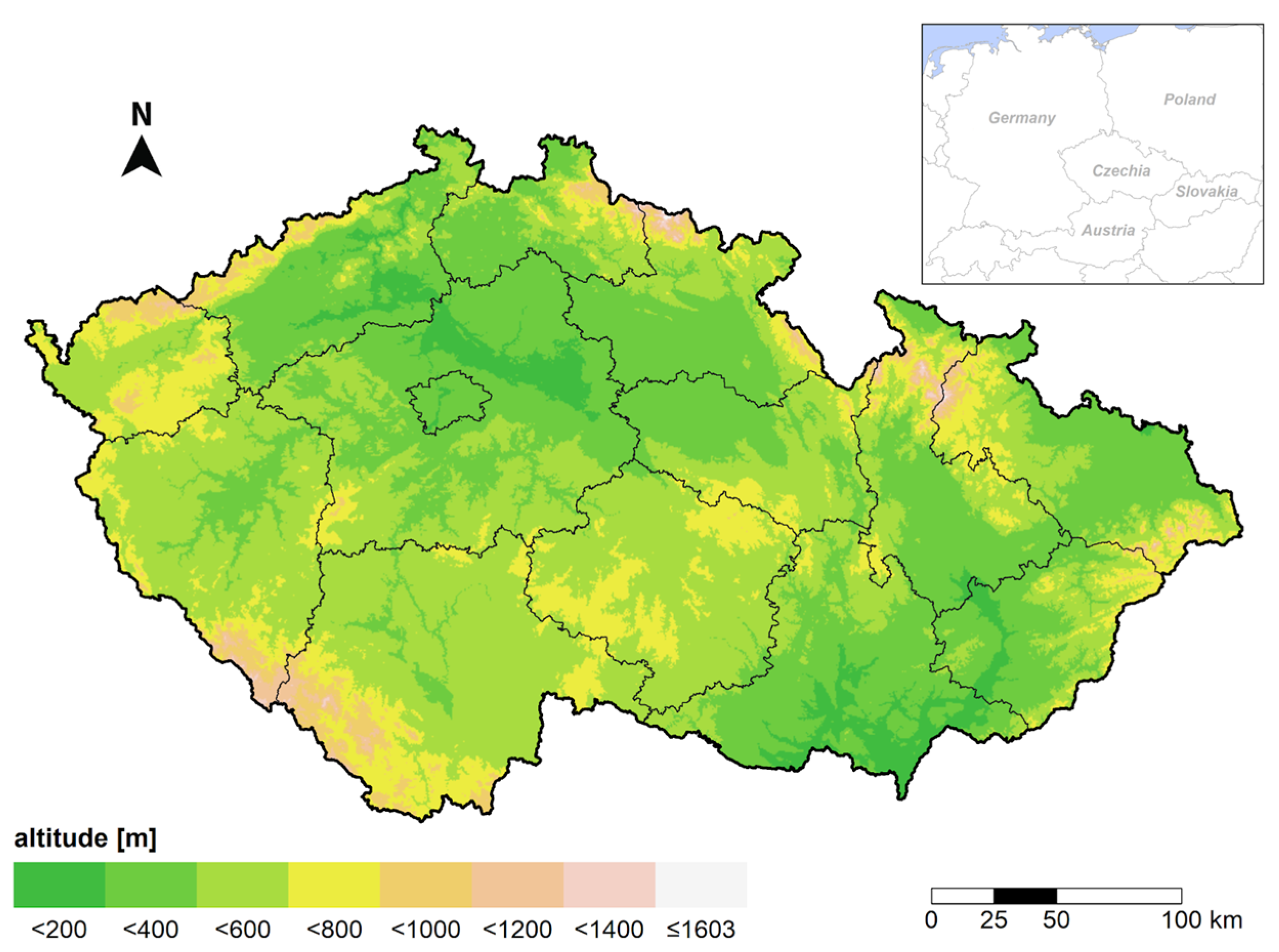

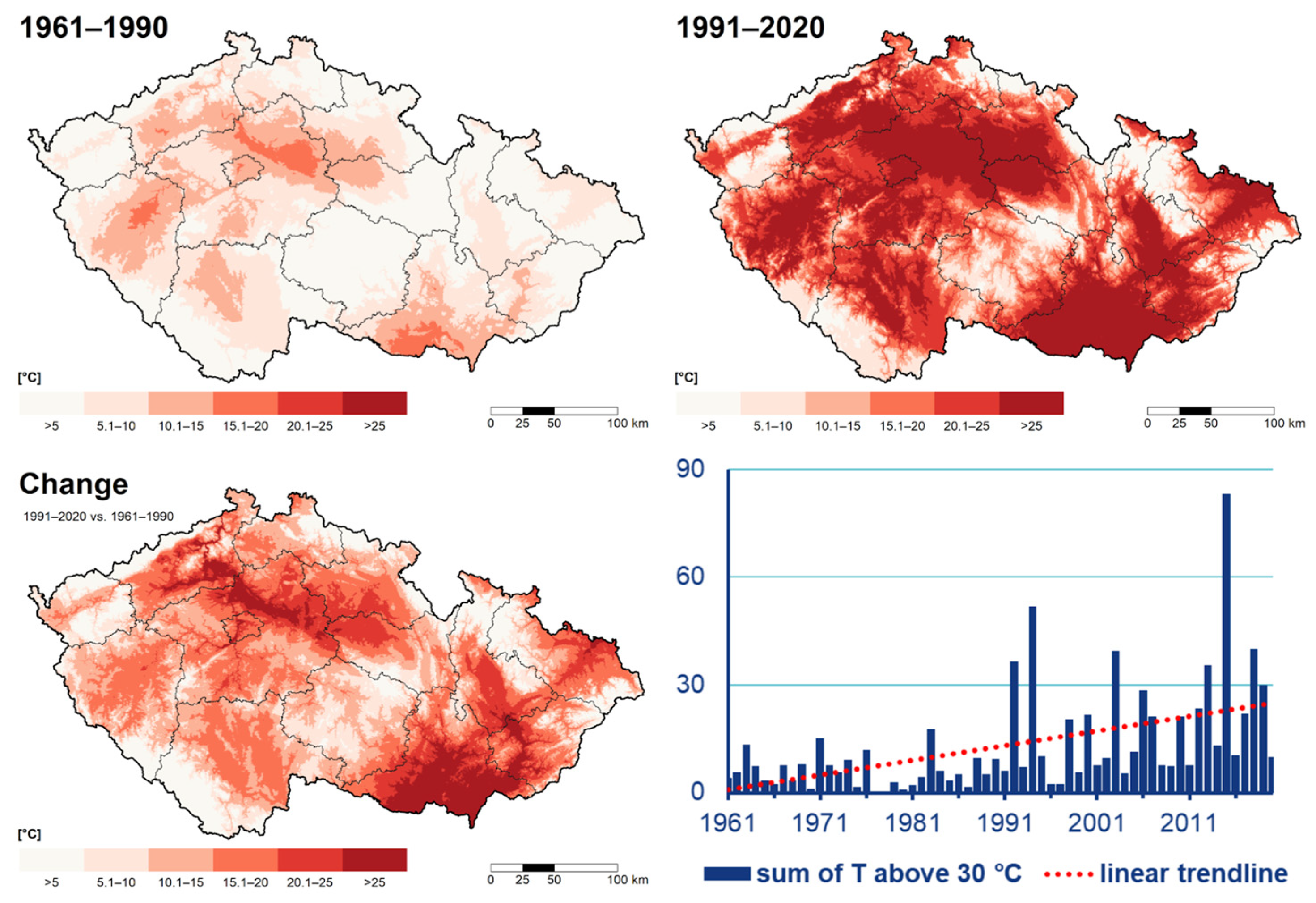
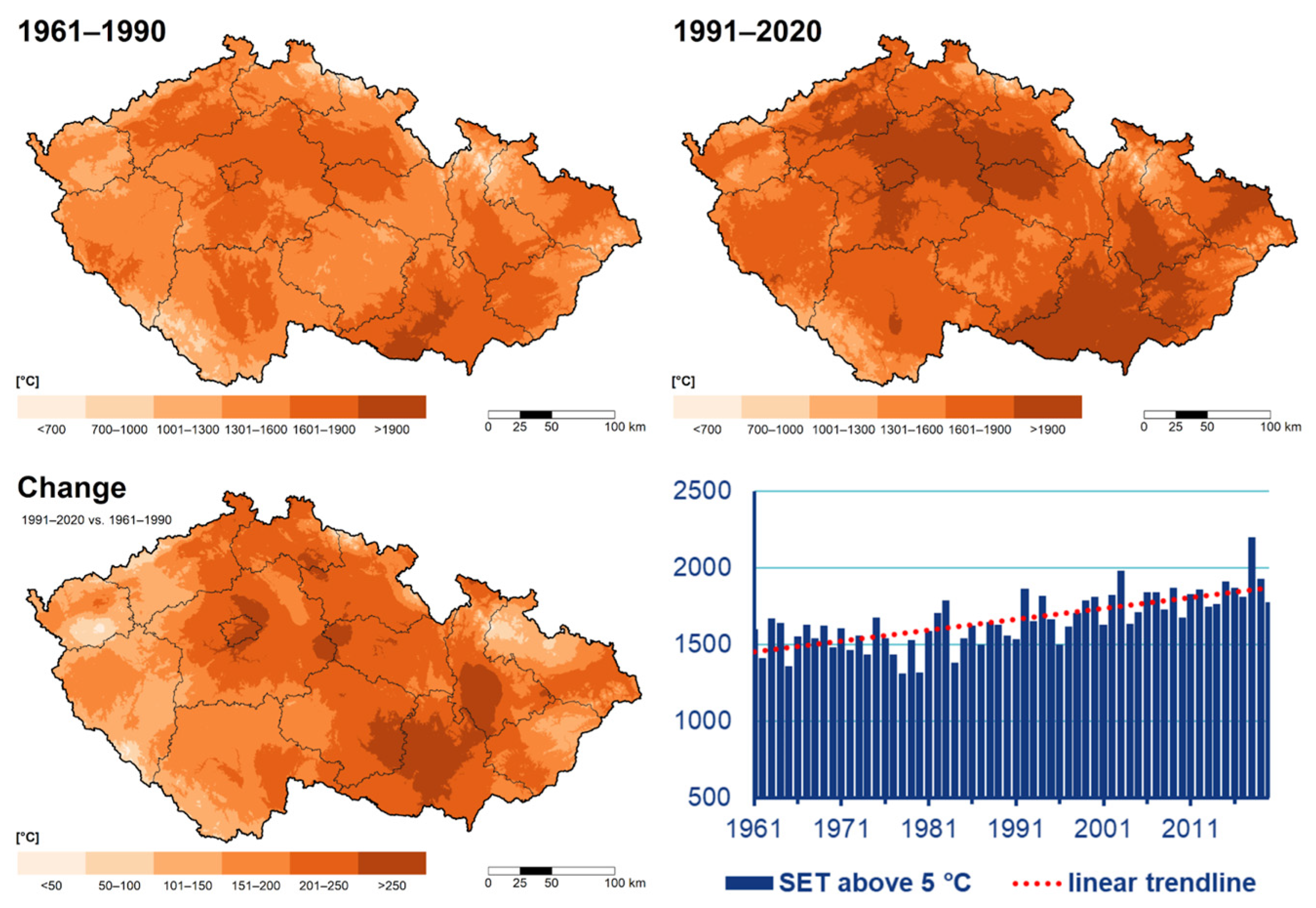
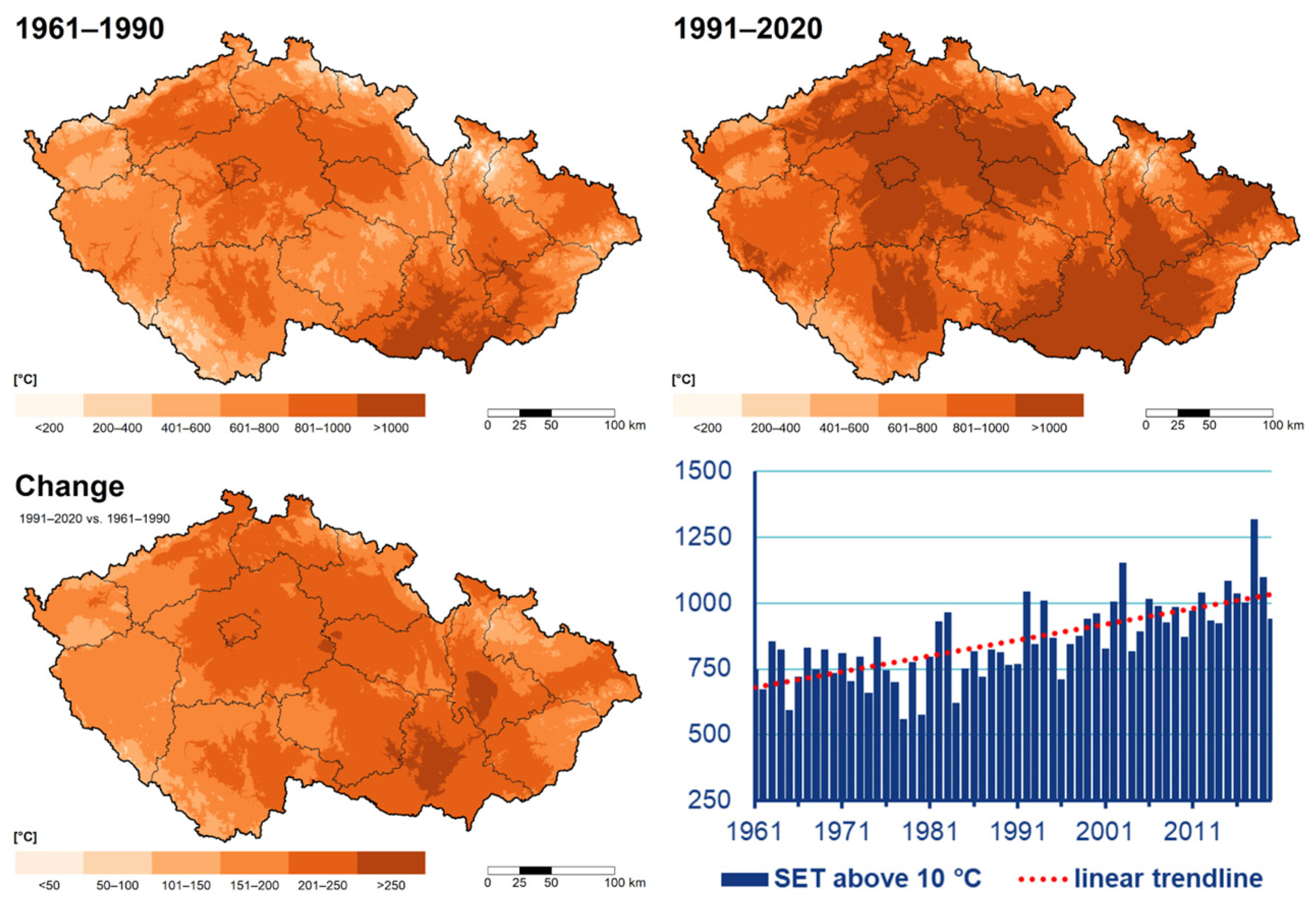
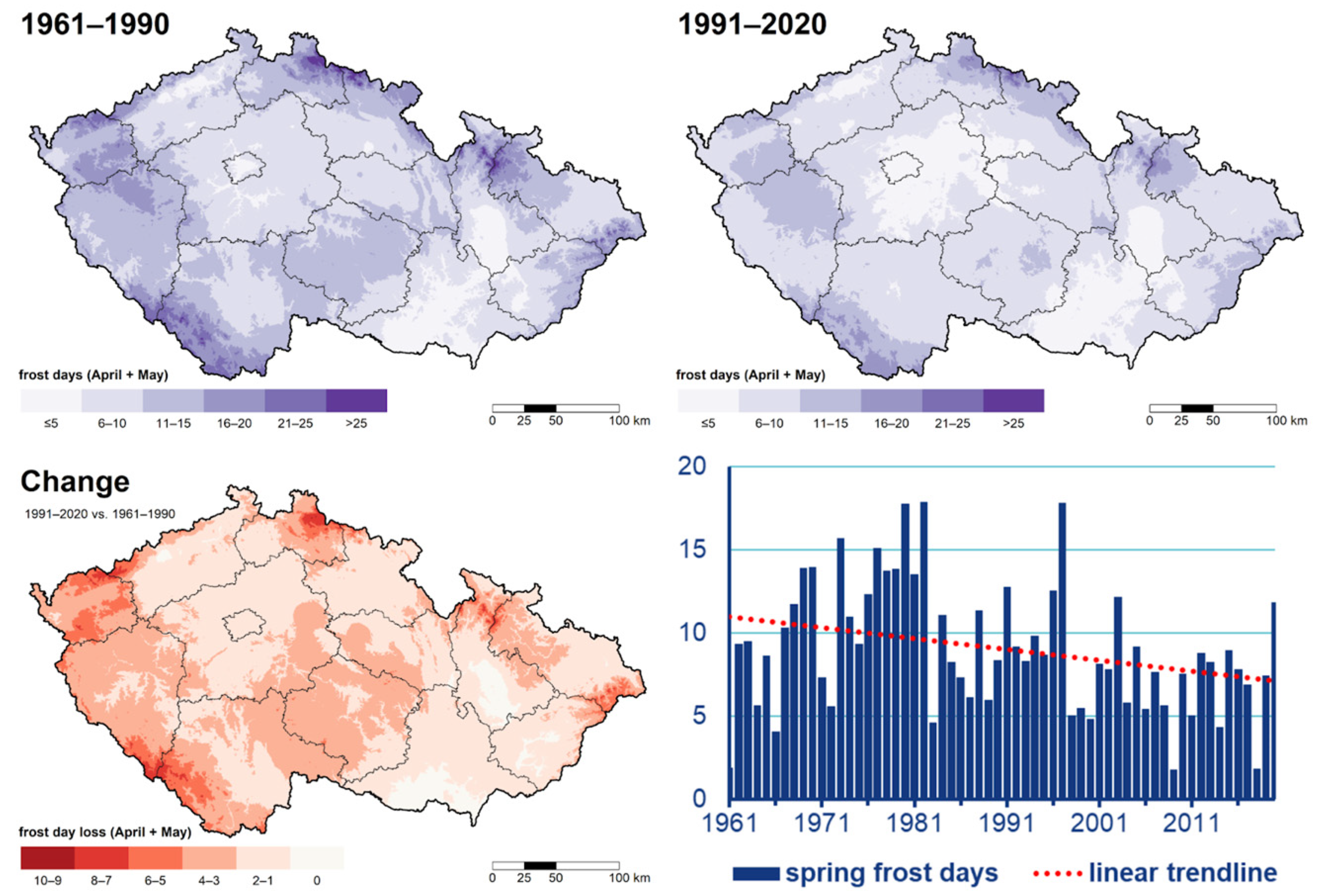
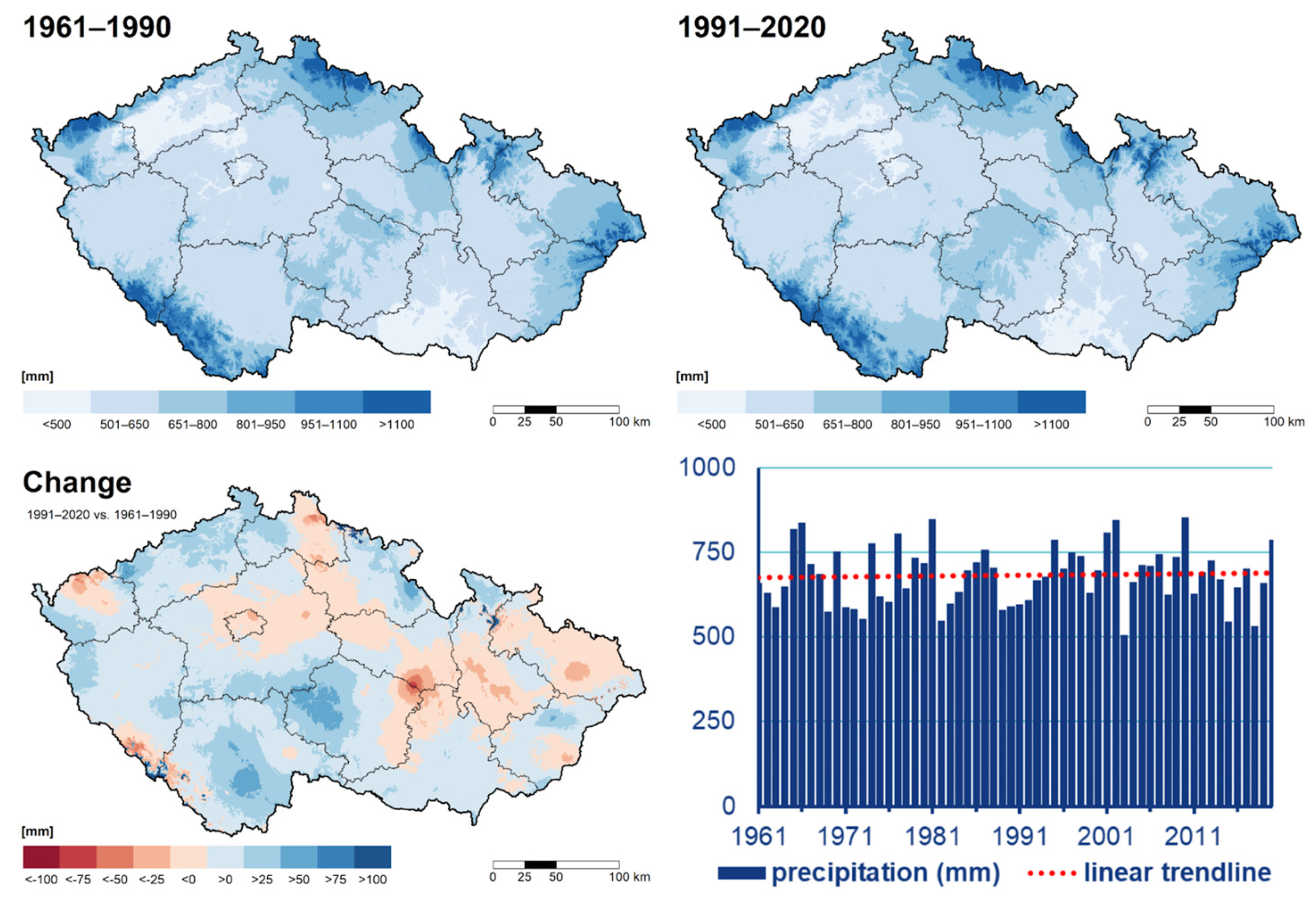

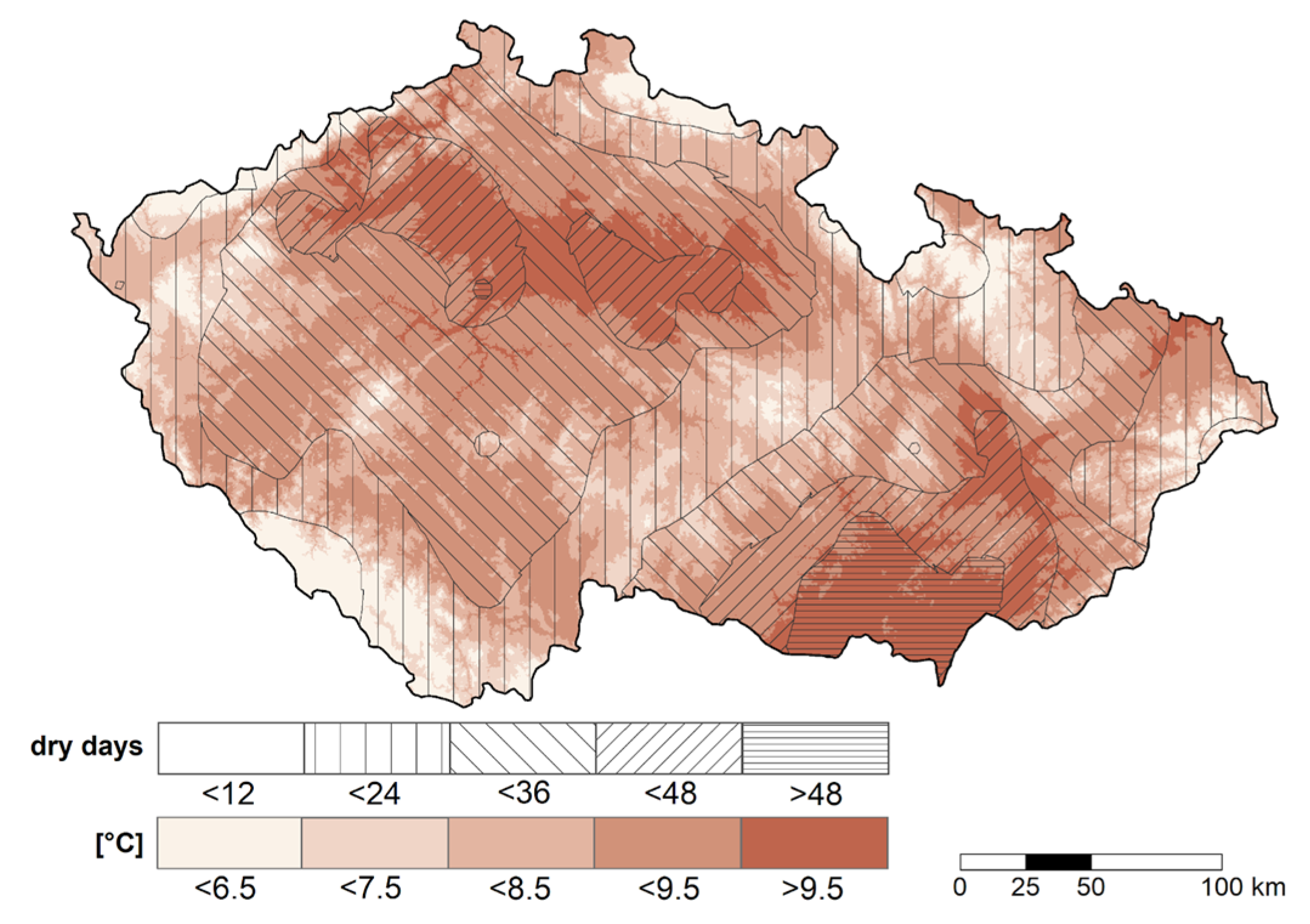
| Agro-Climatic Region | Subregion | Tavg (°C) | Dry Days |
|---|---|---|---|
| Very warm | very dry, dry, slightly dry, slightly wet | >9.5 | >12, <24, <36, <48, >48 |
| Warm | dry, slightly dry, slightly wet | <9.5 | >12, <24, <36, <48 |
| Moderately warm | dry, slightly dry, slightly wet | <8.5 | >12, <24, <36, <48 |
| Moderately cool | slightly dry, slightly wet, wet | <7.5 | <12, <24, <36 |
| Cool | slightly wet, wet | <6.5 | <12, <24 |
Disclaimer/Publisher’s Note: The statements, opinions and data contained in all publications are solely those of the individual author(s) and contributor(s) and not of MDPI and/or the editor(s). MDPI and/or the editor(s) disclaim responsibility for any injury to people or property resulting from any ideas, methods, instructions or products referred to in the content. |
© 2023 by the authors. Licensee MDPI, Basel, Switzerland. This article is an open access article distributed under the terms and conditions of the Creative Commons Attribution (CC BY) license (https://creativecommons.org/licenses/by/4.0/).
Share and Cite
Mozny, M.; Hajkova, L.; Vlach, V.; Ouskova, V.; Musilova, A. Changing Climatic Conditions in Czechia Require Adaptation Measures in Agriculture. Climate 2023, 11, 210. https://doi.org/10.3390/cli11100210
Mozny M, Hajkova L, Vlach V, Ouskova V, Musilova A. Changing Climatic Conditions in Czechia Require Adaptation Measures in Agriculture. Climate. 2023; 11(10):210. https://doi.org/10.3390/cli11100210
Chicago/Turabian StyleMozny, Martin, Lenka Hajkova, Vojtech Vlach, Veronika Ouskova, and Adela Musilova. 2023. "Changing Climatic Conditions in Czechia Require Adaptation Measures in Agriculture" Climate 11, no. 10: 210. https://doi.org/10.3390/cli11100210
APA StyleMozny, M., Hajkova, L., Vlach, V., Ouskova, V., & Musilova, A. (2023). Changing Climatic Conditions in Czechia Require Adaptation Measures in Agriculture. Climate, 11(10), 210. https://doi.org/10.3390/cli11100210







